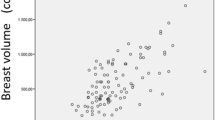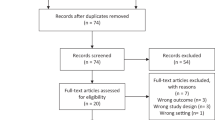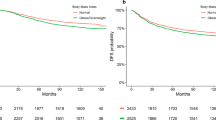Abstract
Introduction:
Obesity is a risk factor for postmenopausal breast cancer and is independently associated with shorter disease-free and overall survival. Currently, in clinical settings, the combination of stage and grade of cancer at the initial presentation of the disease is the best prognostic indicator.
Objective:
To evaluate the association between body mass index (BMI) and risk of advanced stages and poorly differentiated grade of breast cancer.
Design:
A case-series study of women diagnosed with their first primary invasive breast cancer. Patients include a total of 831 women aged ⩾40 years with a mean BMI of 29.6(±6.6) kg m−2. Pathological, clinical and demographic data were retrieved from electronic medical records. Multinomial logistic regression analysis was preformed to estimate the risk of more advanced stages and poorly differentiated grade of cancer, adjusting for covariates.
Results:
Obese compared with normal weight women had an 80% increased risk of cancer with more advanced stages (III/IV) and poorly differentiated grade (odds ratio=1.80, 95% confidence interval 1.13–2.86, P=0.014). No significant increase in risk was observed for overweight women.
Conclusion:
Obesity at the time of diagnosis of breast cancer is associated with more advanced stages and poorly differentiated grade of cancers.
This is a preview of subscription content, access via your institution
Access options
Subscribe to this journal
Receive 12 print issues and online access
$259.00 per year
only $21.58 per issue
Buy this article
- Purchase on Springer Link
- Instant access to full article PDF
Prices may be subject to local taxes which are calculated during checkout

Similar content being viewed by others
References
Ahn J, Schatzkin A, Lacey Jr JV, Albanes D, Ballard-Barbash R, Adams KF et al. Adiposity, adult weight change, and postmenopausal breast cancer risk. Arch Intern Med 2007; 167: 2091–2100.
Majed B, Moreau T, Senouci K, Salmon RJ, Fourquet A, Asselain B . Is obesity an independent prognosis factor in women breast cancer? Breast Cancer Res Treat 2008; 111: 329–342.
Cummings SR, Tice JA, Bauer S, Browner WS, Cuzick J, Ziv E et al. Prevention of breast cancer in postmenopausal women: approaches to estimating and reducing risk. J Natl Cancer Inst 2009; 101: 384–398.
Eliassen AH, Colditz GA, Rosner B, Willet WC, Hankinson SE . Adult weight change and risk of postmenopausal breast cancer. JAMA 2006; 296: 193–201.
Folson AR, Kaye SA, Prineas RJ, Potter JD, Gapstur SM, Wallace RB . Increased incidence of carcinoma of the breast is associated with abdominal adiposity in postmenopausal women. Am J Epidemiol 1990; 131: 794–803.
Hankinson SE, Willet WC, Colditz G, Hunter DJ, Michaud DS, Deroo B et al. Circulating concentration of insulin-like growth factor-I and risk of breast cancer. Lancet 1998; 351: 1393–1395.
Hankinson SE, Willet WC, Manson JE, Colditz GA, Huntr DJ, Spiegelman D et al. Plasma sex steroid hormone levels and risk of breast cancer in postmenopausal women. J Natl Cancer Inst 1998; 90: 1292–1299.
Haffner SM, Dunn JF, Katz MS . Relationship of sex hormone binding globulin to lipid, lipoprotein, glucose, and insulin concentrations in postmenopausal women. Metabolism 1992; 41: 278–284.
Cleveland RJ, Eng SM, Abrahamson PE, Britton JA, Teitelbaum SL, Neugut AI et al. Weight gain prior to diagnosis and survival from breast cancer. Cancer Epidemio Biomarkers Prev 2007; 16: 1803–1811.
Michaelson JS, Silverstein M, Wyatt J, Weber G, Moore R, Halpern E et al. Predicting the survival of patients with breast carcinoma using tumor size. Cancer 2002; 95: 713–723.
Roberti NE . The role of histologic grading in the prognosis of patients with carcinoma of the breast. Is this a neglected opportunity? Cancer 1997; 80: 1708–1716.
Stokes ME, Davis CS, Koch GG (eds). Categorical Data Analysis Using the SAS System 2nd edition SAS Institute Inc.: Cary, NC, 2000.
Cui Y, Whiteman MK, Flaws JA, Langenberg P, Tkaczuk KH, Buxh TL . Body mass and stage of breast cancer at diagnosis. Int J Cancer 2002; 98: 279–283.
Kerlikowske K, Walker R, Miglioretti DL, Desai A, Ballard-Barbash R, Buist DSM . Obesity, mammography use and accuracy, and advanced breast cancer risk. J Natl Cancer Inst 2008; 100: 1724–1733.
Porter GA, Inglis KM, Wood LA, Veugelers PJ . Effect of obesity on presentation of breast cancer. Ann Surg Oncol 2006; 13: 327–332.
Majed B, Moreau T, Senouci K, Salmon RJ, Fourgquet A, Asselain B . Is obesity an independent prognosis factor in woman breast cancer? Breast Cancer Res Treat 2008; 111: 329–342.
Griggs JJ, Sorbero ME, Stark A, Heininger SE, Dick AW . Racial/ethnic disparity in the dose and dose intensity of breast cancer adjuvant chemotherapy. Breast Cancer Res Treat 2003; 81: 21–31.
Stoll BA . Obesity and breast cancer. Int J Obes Relat Metab Disord 1996; 20: 389–392.
Madarnas Y, Sawka CA, Franssen E, Bjarnason GA . Are medical oncologists biased in their treatment for the large women with breast cancer? Breast Cancer Res Treat 2001; 66: 123–133.
Sprague BL, Trentham-Dietz A, Egan KM, Titus-Ernstoff L, Hampton JM, Newcomb PA . Proportion of invasive breast cancer attributable to risk factors modifiable after menopause. Am J Epidemiol 2008; 168: 404–411.
Centers for Disease Control Prevention.. US Obesity Trends 1985–2006. http://www.cdc.gov/obesity/data/trends.html.
Stark A, Stahl M, Krum S, Prichard J, Evans J . Findings from a cohort of women diagnosed with their first primary invasive breast cancer in northeastern and central Pennsylvania. Unpublished data.
National Cancer Institute. Surveillance Epidemiology and End Results; available at http://seer.cancer.gov/statfacts/html/breast.html.
Acknowledgements
This work was partially supported by a grant from the Geisinger Research Endowment Fund.
Author information
Authors and Affiliations
Corresponding author
Ethics declarations
Competing interests
The authors declare no conflict of interest.
Rights and permissions
About this article
Cite this article
Stark, A., Stahl, M., Kirchner, H. et al. Body mass index at the time of diagnosis and the risk of advanced stages and poorly differentiated cancers of the breast: findings from a case-series study. Int J Obes 34, 1381–1386 (2010). https://doi.org/10.1038/ijo.2010.69
Received:
Revised:
Accepted:
Published:
Issue Date:
DOI: https://doi.org/10.1038/ijo.2010.69
Keywords
This article is cited by
-
A retrospective study in tumour characteristics and clinical outcomes of overweight and obese women with breast cancer
Breast Cancer Research and Treatment (2023)
-
Empirical Likelihood Test for Regression Coefficients in High Dimensional Partially Linear Models
Journal of Systems Science and Complexity (2021)
-
Secreted factors derived from obese visceral adipose tissue regulate the expression of breast malignant transformation genes
International Journal of Obesity (2016)
-
Body fatness and breast cancer risk in women of African ancestry
BMC Cancer (2013)
-
Impact of Obesity on Development and Progression of Mammary Tumors in Preclinical Models of Breast Cancer
Journal of Mammary Gland Biology and Neoplasia (2013)



